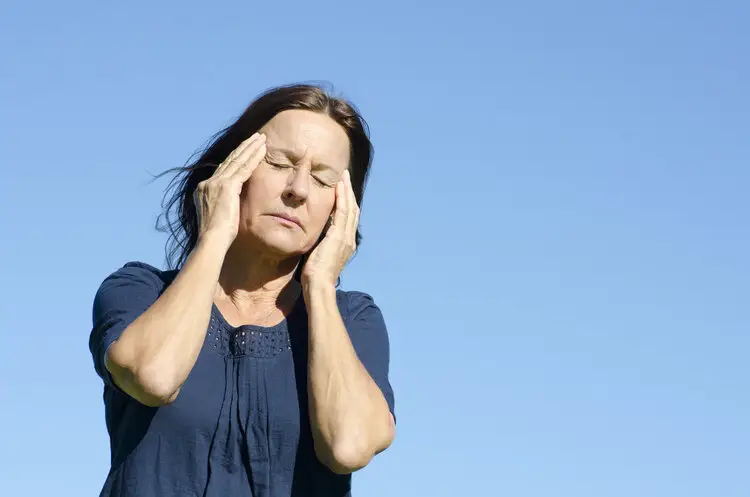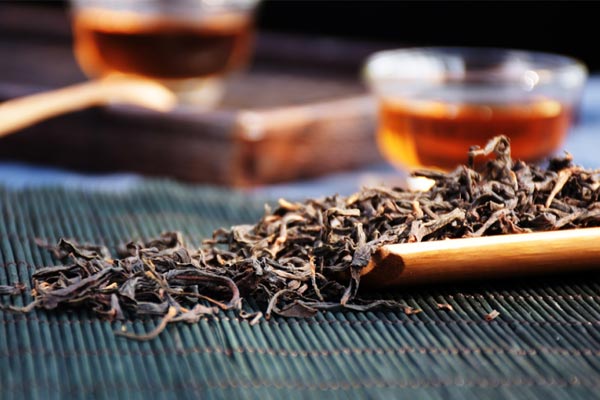"Spring Water, Autumn Fragrance" is a saying that describes the quality characteristics of Tieguanyin tea, emphasizing that spring tea is known for its water quality, while autumn tea is known for its aroma.
But is there any scientific basis for this statement?
How significant is the difference in aroma between spring and autumn Tieguanyin?
Recently, a research team from Fujian Agriculture and Forestry University in China published a research paper titled "The Impact of Harvest Season on Oolong Tea Aroma Profile and Quality" in the journal Plants. By analyzing 266 samples of Anxi Tieguanyin tea, they finally clarified the relationship between season and aroma.

◆ Research Results
01. Autumn Tea Has a More Intense Aroma
The research team selected Tieguanyin tea from Anxi, Fujian, as their research subject. This region is the core production area of Tieguanyin, with representative climate and production techniques. They collected a total of 266 samples from the autumn of 2020 and the spring of 2021, covering two mainstream aroma types: light and strong, and across different price tiers to ensure representative results.
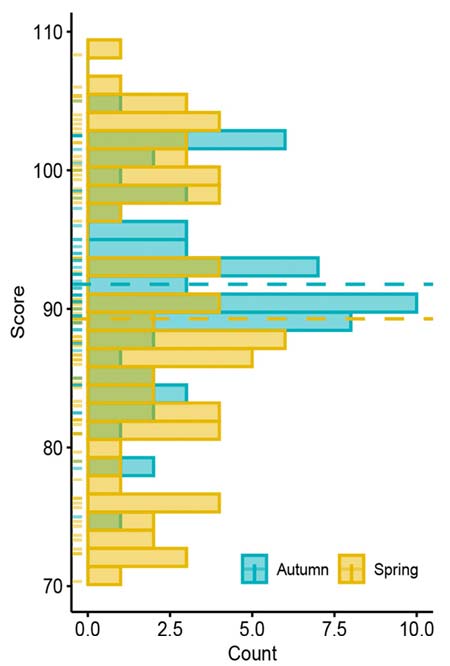
Aroma Ratings of Spring (Yellow) and Autumn (Blue) Tieguanyin Teas
By individually rating the aroma intensity, persistence, freshness, and purity of these samples, they found that only the light-aroma Tieguanyin teas showed a discernible difference, with autumn teas scoring only slightly higher on average than spring teas. The advantage of autumn teas lies in their richer aroma.
02. Season Has a Certain Impact on Light Aroma
By comparing 181 volatile compounds identified in the samples, the researchers found
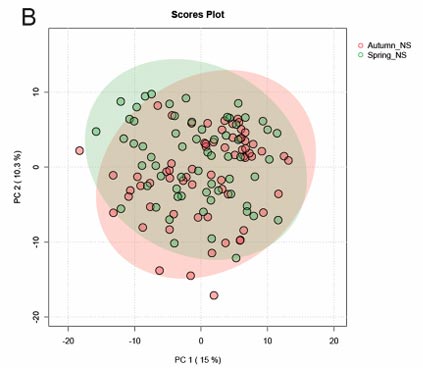
The aroma of strong-aroma Tieguanyin teas from different seasons is relatively similar.
Strong-aroma Tieguanyin teas are completely indistinguishable by season.
This is because strong-aroma Tieguanyin teas undergo high-temperature roasting, a process that causes the loss or conversion of most volatile compounds, resulting in a significant homogeneity of aroma components between the spring and autumn samples.
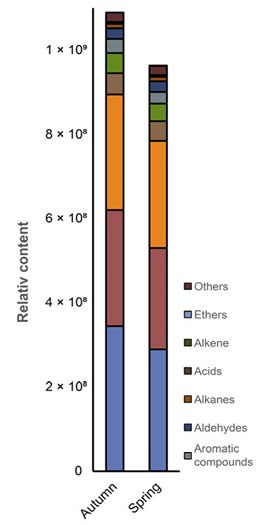
The total aroma of Tieguanyin tea is higher in autumn than in spring.
In contrast, there are certain differences between the light-fragrant Tieguanyin teas of different seasons.
First, the total amount of volatile compounds in autumn tea is higher than that in spring tea, which coincides with the stronger aroma of autumn tea.
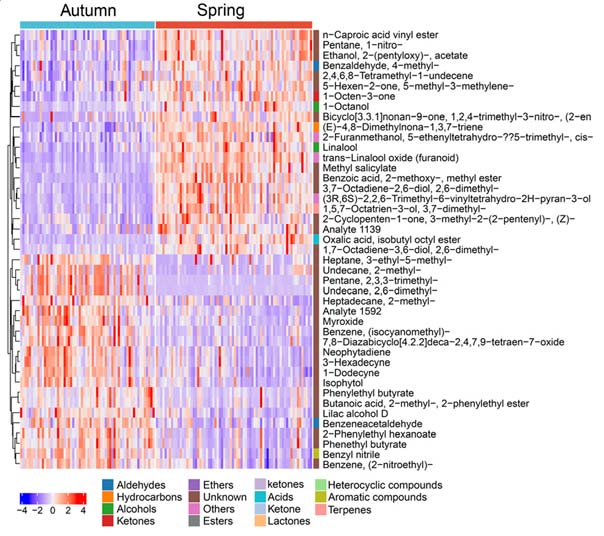
Volatile Components of Tieguanyin Tea in Different Seasons
The team then identified 64 "seasonally differential compounds," the most critical of which is the "linalool family."
This includes linalool itself, its oxides (trans-furan and trans-pyran), and its metabolites (dehydrolinalool).
These compounds have a light floral fragrance and are found in higher concentrations in spring tea than in autumn tea.
The reason is simple: the temperature (19.57-29.57°C in spring, 20.43-29.33°C in autumn) and sunshine (13 hours in spring, 12 hours in autumn) in Anxi are not significantly different between spring and autumn.
However, the air humidity varies significantly, with average precipitation in spring being 409 mm and in autumn only 4.19 mm. On the one hand, the humid spring weather favors leafhopper reproduction, promoting an increase in linalool metabolites; on the other hand, high humidity also inhibits the release of plant volatile compounds.
03. Tea Grade Has a Greater Impact
More importantly, researchers found that the influence of season on aroma quality is far less significant than tea grade.
High-grade Tieguanyin tends to have a longer-lasting and purer aroma.
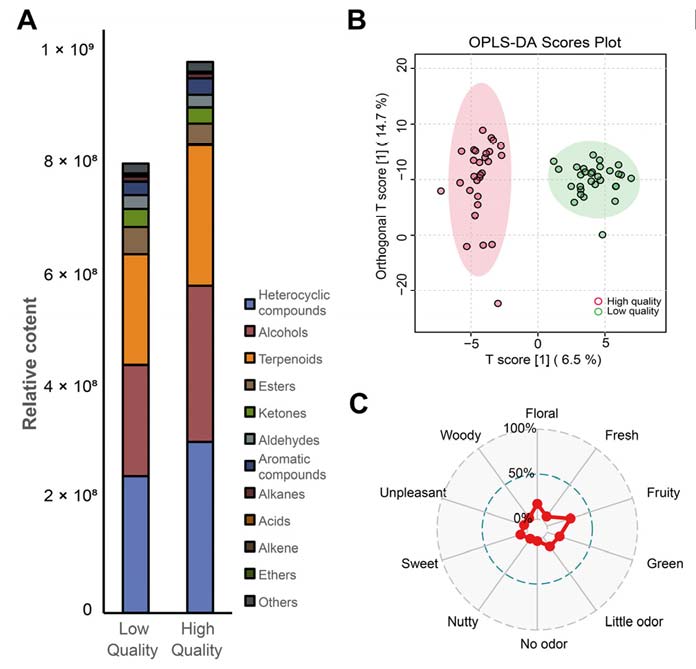
Comparison of Aromatic Compounds in Different Tieguanyin Grades
This is due to the higher levels of "fatty acid degradation products" in high-grade, light-fragrant Tieguanyin, such as trans-3-hexenylbutyrate and trans-2-hexenylhexanoate.
These compounds smell fresh, grassy, and fruity, and have a "low aroma threshold"—meaning that even a small amount can enhance the overall aroma and even amplify it when combined with other compounds.
◆ Conclusion
This study, using 266 samples, high-tech testing, and professional evaluation, shows that there's no need to blindly pursue "autumn tea" or "spring tea."
You can choose the light-fragrance Tieguanyin according to your preference (if you like a strong aroma, choose autumn tea; if you like a refreshing aroma, choose spring tea).
For the strong-fragrance Tieguanyin, you don’t have to worry about the season, and the key is to look at the grade of the tea.

%20--%3e%3c!DOCTYPE%20svg%20PUBLIC%20'-//W3C//DTD%20SVG%201.1//EN'%20'http://www.w3.org/Graphics/SVG/1.1/DTD/svg11.dtd'%3e%3csvg%20version='1.1'%20id='图层_1'%20xmlns='http://www.w3.org/2000/svg'%20xmlns:xlink='http://www.w3.org/1999/xlink'%20x='0px'%20y='0px'%20width='256px'%20height='256px'%20viewBox='0%200%20256%20256'%20enable-background='new%200%200%20256%20256'%20xml:space='preserve'%3e%3cpath%20fill='%23FFFFFF'%20d='M194.597,24.009h35.292l-77.094,88.082l90.697,119.881h-71.021l-55.607-72.668L53.229,232.01H17.92%20l82.469-94.227L13.349,24.009h72.813l50.286,66.45l58.148-66.469V24.009z%20M182.217,210.889h19.566L75.538,44.014H54.583%20L182.217,210.889z'/%3e%3c/svg%3e)


